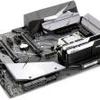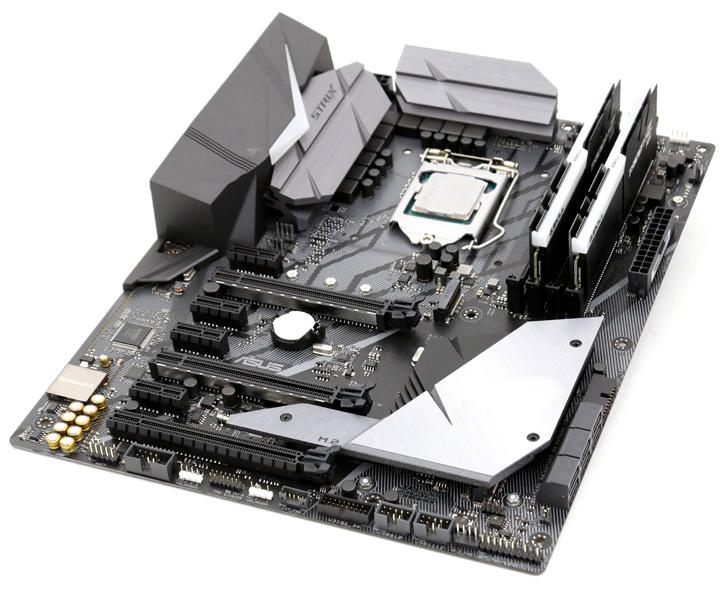Final Words & Conclusion
Conclusion
I haz gotta say ... aside from it's full and too long name (ASUS ROG STRIX Z370-F GAMING) I really like this STRIX, the overall performance is exceptional and in some less threaded cases even the fastest we have seen. However, this is related to the BIOSes being released nearly on a daily basis prior to launch. You may expect all Z370 boards and brands perform toughly within the same 2% margin of error with an exception here and there. The Strix is a looker and has a certain appeal to it. Overclocking wise we reached a stable 5.2 GHz, and that is onall six cores 100% stable of our proc sample. We stated it in other reviews, you'll likely see some processors hit 5.3 and others 5.0, but it is along these ranges. The platform (Z370/Coffee Lake) also manages heat and power consumption at very acceptable levels. Overclocked however at 1.380 volts on the CPU, you will pass 80 Degrees C under load and that was with the proc under water (proverbially speaking).
Performance & tweaking
Once tweaked we noticed that the six cores like a bit of extra voltage, we expect all-core tweaks in the 5.1~5.2 GHz marker to need 1.35~1.39 Volts on the processor. While that does increase power consumption, it wasn't something that scared me away. Some platforms will and procs will also be able to manage a lower voltage. On this board temps at such voltages / frequency ranges reached 75 Degrees C for 5.1 GHz. We did use an ES sample, perhaps the final retail product can do with a little less juice. If you plan a tweak at that 5 GHz marker then remember my remarks on cooling, you will need LCS, that or a very good heatpipe cooler. Again, we have been using an ES sample so I cannot say anything conclusive on the final retail products (these might run a tiny bit cooler). The infrastructure that Z370 offers is easy to use, you increase the CPU voltage and multiplier and you are good to go. Another plus for the Intel platform is that over the years they have been able to refine their memory controllers, pop in anything XMP 2.0 and you have a 90% change it'll work straight out of the box with very fast memories. Mind you that all our tests are performed at 3200 MHz DDR4, similar to Ryzen and Threadripper to remain objective and for fair play on both sides.
Power consumption
Z370 with a six cores and twelve threaded proc equals to a 95 Watt TDP processor. With the system at idle with a GeForce GTX 1080 installed / 16 GB memory / SSD and the Z370 motherboard. Typically you will hover at roughly 50 Watts in IDLE. The board is within the baseline of the rest of the tested Z370 motherboards. When we stressed the processor 100% run we reach roughly 150 Watts with the 6-core 8700K part overall. When we game we hover at ~250 Watts with the GeForce GTX 1080, but obviously that factor is dependent on the type of graphics card you use of course and sure, most games certainly do not utilize the six CPU cores. Overall I have no worries here.
DDR4 Memory
For Coffee Lake (8th Gen Intel procs) DDR4 may be clocked a notch faster at 2400/2667 MHz as per Intel reference. We always say, volume matters more than frequency. A 3200 MHz kit for example is far more expensive and does offer better bandwidth but the performance increases in real-world usage will be hard to find. Unless you transcode videos over the processor a lot. As always, my advice would be to go with lower clocked DDR4 memory with decent timings, but get more of it. Don't go for 8 GB, get four DIMMs and in total a minimum of 16 GB. The reason we test at 3200 MHz is simple, we do the same for AMD Ryzen and want to create a fair and equal playing ground for both. We however have added a 3866 MHz kit as a bit of extra to show how easy it is to get closer to that 4 GHz DDR4 domain (not that such a high frequency is really relevant but it is fun to see the bandwidth scores). The G.Skill memory wasn't supported in the initial BIOS we tried, but booted totally fine with an XMP at 3866 CL18 once we tried BIOS revision 0402.
Final words
Originally introduced in the graphics card segment the STRIX has a certain appeal. ASUS moved it towards the entry level segment for their motherboards, then a year later it was mainstream to high-end, and right now we feel is is targeted solely at that high-end segment. It's a good board, but high-end will also come with a more high-end price level. ASUS hwoever sticks to a fairly simplistic feature-set (they use what the Intel chipset offers and not a lot more). Additional extra's are found in ASMEdia USB 3.1 Gen2 and two Ms slots. The rest is all about styling as for the Strix ASUS tries to give it a ROG yet STRIX feel. That woks well, the heatsink look lovely and slowly but steadily you can see the separation of STRIX from an ROG design, which is a little weird as it still is an ROG board :) Ah well ... I'd like to suggest to ASUS to separate the STRIX from ROG branding for a little more market clarity. Then again i also understadn why they would like that ROG logo on the box, it sells better in the stores.
The two M2 slots come at the cost of SATA connector ports. For example the second M2 slot runs at PCIe Gen x2. In the BIOS you can activate the x4 mode which you really need for full performance, but at the cost of an SATA or PCIe slot. It's not the fault of ASUS, it's just that Intel chipset simply runs out of PCIE lanes. Missing is WIFI and neither does it come with a preferred a 5G or 10G LAN Jack. Connectivity wise in terms of your PCIe slots for your graphics subsystem you are looking at a full x16 Gen 3 lanes for one graphics cards. The second and PCIe slot shares it's lanes with the first one, ergo you'd end up at configuration like x8/x8. The third x16 slot, in fact is a x4 slot which draws its lanes from the chipset. We expect anything Coffee lake to be able to manage the 5 GHz domain on all cores with exceptions running up towards 5.2 GHz (all-core). I base this metric on high-perf aircoolers and liquid cooling. From there on-wards you are looking at proc ASIC quality and cooling being the more important denominator. In the end we can be short about this STRIX, it's really good. There is some complexity going on with available PCIe lanes, but that is the same for all manufacturers really. The board performance really good, was stable and has awesome looks (if you like the style of course). Definitely recommended by Guru3D.com
Handy related downloads:
- Sign up to receive a notice when we publish a new article
- Or go back to Guru3D's front page.



